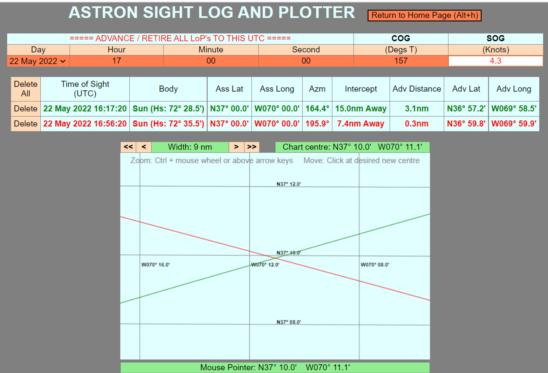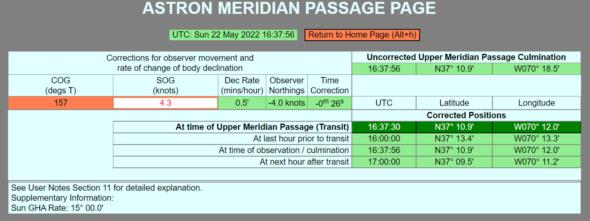
NavList:
A Community Devoted to the Preservation and Practice of Celestial Navigation and Other Methods of Traditional Wayfinding
From: Bill Ritchie
Date: 2021 Sep 2, 14:13 -0700
Frank, you asked “Does your app handle a case like this?“.
My initial reaction, as the altitudes were so high, was to treat it as a zenith fix. The SightLogPage image shows Astron using just the first and last observations. The difference in azimuth over 39 minutes is a useable 31° and gives a position at 1700 of N37° 10.0' W070° 11.1', much in accord with other results. This was after forcing the total altitude corrections to +13.0’.
To return to the question, Astron does not include a vector addition facility, nor does it analyse a noon series to determine time and altitude at culmination. So I used 157°/4.3kn, a culmination time of 16:37:56 (mid of Antoine and Tony’s estimates) and assumed the maximum altitude was the same as the 16:39:15 Hs of 73° 04.5’. With these values, Astron’s Meridian Passage Page gives values in close agreement with Peter, Antoine and Tony's results.
Time Correction -0m 26s. (Wilson formula)
Transit at 16:37:30 N37° 10.9’ W070° 12.0’.
Position at 17:00:00 N37° 09.5’ W070° 11.2’
The MP_Page image shows Astron’s Meridian Passage page. I have today added the code for the “last hour and next hour” positions, having been inspired to do so by this thread. I will publish the update in a few days after I have checked for bugs and also added similar to the Lower Meridian Passage code.
Bill Ritchie 50N 003W








